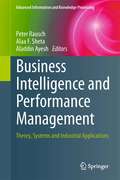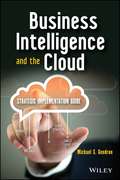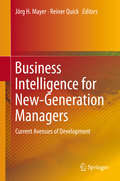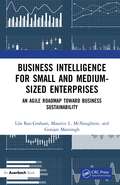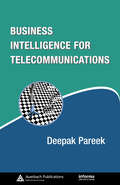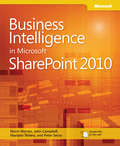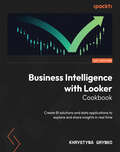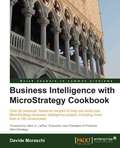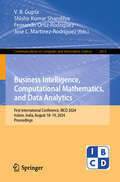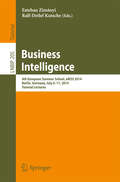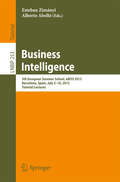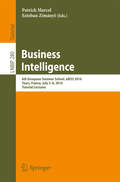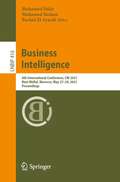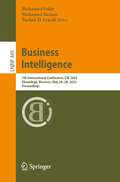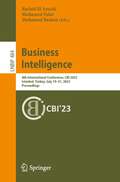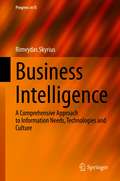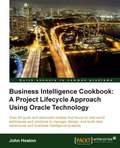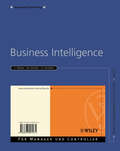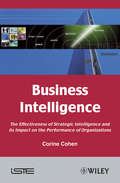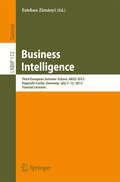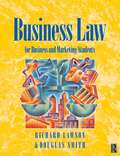- Table View
- List View
Business Intelligence and Performance Management: Theory, Systems and Industrial Applications (Advanced Information and Knowledge Processing)
by Alaa F. Sheta Aladdin Ayesh Peter RauschDuring the 21st century business environments have become more complex and dynamic than ever before. Companies operate in a world of change influenced by globalisation, volatile markets, legal changes and technical progress. As a result, they have to handle growing volumes of data and therefore require fast storage, reliable data access, intelligent retrieval of information and automated decision-making mechanisms, all provided at the highest level of service quality. Successful enterprises are aware of these challenges and efficiently respond to the dynamic environment in which their business operates. Business Intelligence (BI) and Performance Management (PM) offer solutions to these challenges and provide techniques to enable effective business change. The important aspects of both topics are discussed within this state-of-the-art volume. It covers the strategic support, business applications, methodologies and technologies from the field, and explores the benefits, issues and challenges of each. Issues are analysed from many different perspectives, ranging from strategic management to data technologies, and the different subjects are complimented and illustrated by numerous examples of industrial applications. Contributions are authored by leading academics and practitioners representing various universities, research centres and companies worldwide. Their experience covers multiple disciplines and industries, including finance, construction, logistics, and public services, amongst others. Business Intelligence and Performance Management is a valuable source of reference for graduates approaching MSc or PhD programs and for professionals in industry researching in the fields of BI and PM for industrial application.
Business Intelligence and the Cloud
by Michael S. GendronHow to measure cloud computing options and benefits to impact business intelligence infrastructureThis book is a guide for managers and others involved in using cloud computing to create business value. It starts with a discussion of the media hype around cloud computing and attempt to pull together what industry experts are saying in order to create a unified definition. Once this foundation is created--assisting the reader's understanding of what cloud computing is--the discussion moves to getting business benefits from cloud computing. Lastly, the discussion focuses on examples of cloud computing, public clouds, private clouds, and virtualization. The book emphasizes how these technologies can be used to create business value and how they can be integrated into an organizations business intelligence system. It helps the user make a business case for cloud computing applications--applications that are used to gather/create data, which in turn are used to generate business intelligence.
Business Intelligence for New-Generation Managers: Current Avenues of Development
by Jörg H. Mayer Reiner QuickExecutives in Europe have significantly expanded their role in operations - in parallel to their strategic leadership. At the same time, they need to make decisions faster than in the past. In these demanding times, a redesigned Business Intelligence (BI) should support managers in their new roles. This book summarizes current avenues of development helping managers to perform their jobs more productively by using 'BI for managers' as their central, hands-on, day-to-day source of information - even when they are mobile.
Business Intelligence for Small and Medium-Sized Enterprises: An Agile Roadmap toward Business Sustainability
by Gunjan Mansingh Lila Rao-Graham Maurice L. McNaughtonBusiness intelligence (BI) has evolved over several years as organizations have extended their online transaction processing (OLTP) capabilities and applications to support their routine operations. With online analytical processing (OLAP), organizations have also established the capability to extract internal and external data from a variety of sources to specifically obtain intelligence about non-routine and often less-structured arrangements. BI therefore refers to applications and technologies that are used to gather, provide access to, and analyze data and information about the operations of an organization. It has the capability of providing comprehensive insight into the more volatile factors affecting the business and its operations, thereby facilitating enhanced decision-making quality and contributing to the creation of business value. Larger and more sophisticated organizations have long been exploiting these capabilities. Business Intelligence for Small and Medium-Sized Enterprises (SMEs) guides SMEs in replicating this experience to provide an agile roadmap toward business sustainability. The book points out that successful BI implementations have generated significant increases in revenue and cost savings, however, the failure rates are also very high. More importantly, it emphasizes that a full range of BI capabilities is not the exclusive purview of large organizations. It shows how SMEs make extensive use of BI techniques to develop the kind of agility endowing them with the organizational capability to sense and respond to opportunities and threats in an increasingly dynamic business environment. It points to the way to a market environment in which smaller organizations could have a larger role. In particular, the book explains that by establishing the agility to leverage internal and external data and information assets, SMEs can enhance their competitiveness by having a comprehensive understanding of the key to an agile roadmap for business sustainability.
Business Intelligence for Telecommunications (Informa Telecoms & Media)
by Deepak PareekBringing together market research reports, business analyst briefings, and technology references into one comprehensive volume, Business Intelligence for Telecommunications identifies those advances in both methods and technology that are being employed to inform decision-making and give companies an edge in the rapidly growing and highly co
Business Intelligence in Microsoft® SharePoint® 2010
by Stacia Misner Mariano Teixeira Neto John Campbell Norman P. WarrenDive into the business intelligence (BI) features in SharePoint 2010--and use the right combination of tools to deliver compelling solutions. This practical guide helps you explore several BI application services available in SharePoint 2010 and Microsoft SQL Server® 2008 R2. You'll learn each technology with step-by-step instructions, and determine which ones work best in specific BI scenarios--whether you're a SharePoint administrator, SQL Server developer, or business analyst. Choose the BI tools that meet your needs--and learn how they work together Examine the BI lifecycle, from determining key performance indicators to building dashboards Take Microsoft Excel® further--gain more control and functionality with web-based Excel Services Mash up data from multiple sources using PowerPivot for Excel 2010 Create data visualizations with objects, context, and metrics using Microsoft Visio® Services Build dashboards, scorecards, and other monitoring and analysis tools with PerformancePoint® Services Use SharePoint to view BI reports side by side, no matter which tools were used to produced them Your companion web content includes: Interactive exercises that help you try out concepts or techniques Code samples that enable you to work with the exercises
Business Intelligence with Looker Cookbook: Create BI solutions and data applications to explore and share insights in real time
by Khrystyna GrynkoUse Looker for visualizing data, data analysis, and reporting, and learn how to connect to your data, build dashboards and reports, and share insights with your teamKey FeaturesExplore data visualization, analysis, and reporting with Looker to gain insights from your dataConnect to data sources, build dashboards, and create reports to track and share key metricsShare insights with your team to make better business decisionsPurchase of the print or Kindle book includes a free PDF eBookBook DescriptionLooker is a data analytics and business intelligence platform that allows organizations to explore, analyze, and visualize their data. It provides tools for data modeling, exploration, and visualization, enabling you to gain insights from your data to make informed business decisions. You’ll start with the basics, from setting up your Looker environments to configuring views and models using LookML. As you progress, you’ll delve into more advanced topics, such as navigating data in Explore, tailoring dashboards to your needs, and adding dynamic elements for interactivity. Along the way, you'll gain invaluable troubleshooting skills to tackle common issues and optimize your Looker usage, ensuring a smooth and seamless experience. Furthermore, the book extends your understanding beyond the basics, equipping you with the knowledge you need to develop Looker applications and seamlessly integrate them with other tools and applications. You'll also explore advanced techniques for harnessing Looker's full potential, empowering you to establish data-driven decision-making and innovation within your organization. By the end of this BI book, you'll have gained a solid understanding of how to use Looker to find important information, make tasks easier, and derive important insights.What you will learnUnderstand Looker's key components, including LookML, data models, and dashboards.Explore Looker's functionality, including custom fields, calculations, and visualizations.Work with Looker dashboards using dynamic elements like links and actions.Use different types of filters for dimensions to create dashboardsDevelop Looker applications using essential tools and frameworksExplore additional applications for the Looker organizationIntegrate Looker with other tools using APIs, connectors, and data pipelinesWho this book is forIf you’re a business analyst, data analyst, or BI developer who wants to get well-versed with the features of Looker, this book is for you. Basic knowledge of business intelligence is required to get started.
Business Intelligence with MicroStrategy Cookbook
by Davide MoraschiWritten in a cookbook style, this book will teach you through the use of recipes with examples and illustrations. Each recipe contains step-by-step instructions about everything necessary to execute a particular task.This book is intended for both BI and database developers who want to expand their knowledge of MicroStrategy. It is also useful for advanced data analysts who are evaluating different technologies. You do not need to be an SQL master to read this book, yet knowledge of some concepts like foreign keys and many-to-many relationships is assumed. Some knowledge of basic concepts such as dimensional modeling (fact tables, dimensions) will also help your comprehension of this book. No previous MicroStrategy knowledge is needed.
Business Intelligence, Computational Mathematics, and Data Analytics: First International Conference, IBCD 2024, Indore, India, August 18–19, 2024, Proceedings (Communications in Computer and Information Science #2413)
by Shishir Kumar Shandilya Fernando Ortiz-Rodríguez V. B. Gupta Jose L. Martinez-RodriguezThis book constitutes the proceedings of the First International Conference on Business Intelligence, Computational Mathematics, and Data Analytics, IBCD 2024, held in Indore, India, during August 18–19, 2024. The conference focus on applied intelligence across data science, mathematics, healthcare, cybersecurity, and business analytics, and will serve as a driving force for transforming theoretical breakthroughs into practical, real-world solutions with meaningful societal impact.
Business Intelligence: 4th European Summer School, eBISS 2014, Berlin, Germany, July 6-11, 2014, Tutorial Lectures (Lecture Notes in Business Information Processing #205)
by Esteban Zimányi Ralf-Detlef KutscheThis book constitutes the tutorial lectures of the 4th European Business Intelligence Summer School, eBISS 2014, held in Berlin, Germany, in July 2014. The tutorials presented here in an extended and refined format were given by renowned experts and cover topics including requirements engineering for decision-support systems, visual analytics of large data sets, linked data and semantic technologies, supervised classification on data streams, and knowledge reuse in large organizations.
Business Intelligence: 5th European Summer School, eBISS 2015, Barcelona, Spain, July 5-10, 2015, Tutorial Lectures (Lecture Notes in Business Information Processing #253)
by Esteban Zimányi Alberto AbellóThis book constitutes the tutorial lectures of the 5th European Business Intelligence Summer School, eBISS 2015, held in Barcelona, Spain, in July 2015. The tutorials presented here in an extended and refined format were given by renowned experts and cover topics including schema evolution for databases and data warehouses, publishing OLAP cubes on the Semantic Web, design issues in social business intelligence projects, context-aware business intelligence, and key performance indicators in data warehouses.
Business Intelligence: 6th European Summer School, eBISS 2016, Tours, France, July 3-8, 2016, Tutorial Lectures (Lecture Notes in Business Information Processing #280)
by Esteban Zimányi Patrick MarcelBusiness Intelligence (BI) promises an organization the capability of collecting and analyzing internal and external data to generate knowledge and value, providing decision support at the strategic, tactical, and operational levels. Business Intelligence is now impacted by the Big Data phenomena and the evolution of society and users, and needs to take into account high-level semantics, reasoning about unstructured and structured data, and to provide a simplified access and better understanding of diverse BI tools accessible trough mobile devices. In particular, BI applications must cope with additional heterogeneous (often Web-based) sources, e. g. , from social networks, blogs, competitors', suppliers', or distributors' data, governmental or NGO-based analysis and papers, or from research publications. The lectures held at the First European Business Intelligence Summer School (eBISS), which are presented here in an extended and refined format, cover not only established BI technologies like data warehouses, OLAP query processing, or performance issues, but extend into new aspects that are important in this new environment and for novel applications, e. g. , semantic technologies, social network analysis and graphs, services, large-scale management, or collaborative decision making. Combining papers by leading researchers in the field, this volume will equip the reader with the state-of-the-art background necessary for inventing the future of BI. It will also provide the reader with an excellent basis and many pointers for further research in this growing field.
Business Intelligence: 6th International Conference, CBI 2021, Beni Mellal, Morocco, May 27–29, 2021, Proceedings (Lecture Notes in Business Information Processing #416)
by Mohamed Fakir Mohamed Baslam Rachid El AyachiThis book constitutes the proceedings of the 6th International Conference on Business Intelligence, CBI 2021, which took place in Beni Mellal, Morocco, during May 27-29, 2021.The 26 full and 6 poster papers included in this book were carefully reviewed and selected from a total of 60 submissions. They were organized in topical sections as follows: decision support, information systems and NLP; big data, datamining, Web services and Web semantics; optimization and decision support; signal, image and vision computing; networking, cloud computing and networking architectures in cloud.
Business Intelligence: 7th International Conference, CBI 2022, Khouribga, Morocco, May 26–28, 2022, Proceedings (Lecture Notes in Business Information Processing #449)
by Mohamed Fakir Mohamed Baslam Rachid El AyachiThis book constitutes the proceedings of the 7th International Conference on Business Intelligence, CBI 2022, which took place in Khouribga, Morocco, during May 26-28, 2022. The 23 full papers included in this book were carefully reviewed and selected from a total of 68 submissions. They were organized in topical sections as follows: decision support and artificial intelligence; business intelligence and database; and optimization and dynamic programming.
Business Intelligence: 8th International Conference, CBI 2023, Istanbul, Turkey, July 19–21, 2023, Proceedings (Lecture Notes in Business Information Processing #484)
by Mohamed Fakir Mohamed Baslam Rachid El AyachiThis book constitutes the refereed proceedings of the 8th International Conference on Business Intelligence, CBI 2023, which held in Istanbul, Turkey, during July 19–21, 2023.The 15 full papers included in this book were carefully reviewed and selected from 50 submissions. They were organized in topical sections as follows: artificial intelligence and business intelligence; and optimization and decision support.
Business Intelligence: A Comprehensive Approach to Information Needs, Technologies and Culture (Progress in IS)
by Rimvydas SkyriusThis book examines the managerial dimensions of business intelligence (BI) systems. It develops a set of guidelines for value creation by implementing business intelligence systems and technologies. In particular the book looks at BI as a process – driven by a mix of human and technological capabilities – to serve complex information needs in building insights and providing aid in decision making. After an introduction to the key concepts of BI and neighboring areas of information processing, the book looks at the complexity and multidimensionality of BI. It tackles both data integration and information integration issues. Bodies of knowledge and other widely accepted collections of experience are presented and turned into lessons learned. Following a straightforward introduction to the processes and technologies of BI the book embarks on BI maturity and agility, the components, drivers and inhibitors of BI culture and soft BI factors like attention, sense and trust. Eventually the book attempts to provide a holistic view on business intelligence, possible structures and tradeoffs and embarks to provide an outlook on possible developments in BI and analytics.
Business Intelligence: A Project Lifecycle Approach Using Oracle Technology Cookbook
by John HeatonThis book is written in a simple, easy to understand format with lots of screenshots and step-by-step explanations. If you are Project Managers or IT professionals looking to design and develop a data warehouse and business intelligence solution, then this is the best guide for you. This book assumes that you have a fundamental knowledge of data warehouse and business intelligence projects.
Business Intelligence: Move Your Business To The Top Using Cyber-intelligence (Advanced Controlling)
by Martin Grothe Jargen Weber Utz SchaumlfferBestehende IT-Lösungen werden in "Business Intelligence" mit einem BI-Portfolio strukturiert. Damit können Controller aktiv eine neue Lösungsqualität erschlieà en.
Business Intelligence: The Effectiveness of Strategic Intelligence and its Impact on the Performance of Organizations
by Corine CohenFollowing a long process of qualitative, quantitative, and empirical research next to Strategic Intelligence (SI) experts and large companies, this book proposes a way to improve SI and its impact on the performance of an organization. From an exploration, description and evaluation model of SI, a measurement tool in two parts has been built. For all kind of firms and all advancement levels of SI, it explains the construction of a control panel which can be used to pilot SI and its impact on the performance of an organization.
Business Intelligence: Third European Summer School, eBISS 2013, Dagstuhl Castle, Germany, July 7-12, 2013, Tutorial Lectures (Lecture Notes in Business Information Processing #172)
by Esteban ZimányiTo large organizations, business intelligence (BI) promises the capability of collecting and analyzing internal and external data to generate knowledge and value, thus providing decision support at the strategic, tactical, and operational levels. BI is now impacted by the "Big Data" phenomena and the evolution of society and users. In particular, BI applications must cope with additional heterogeneous (often Web-based) sources, e. g. , from social networks, blogs, competitors', suppliers', or distributors' data, governmental or NGO-based analysis and papers, or from research publications. In addition, they must be able to provide their results also on mobile devices, taking into account location-based or time-based environmental data. The lectures held at the Third European Business Intelligence Summer School (eBISS), which are presented here in an extended and refined format, cover not only established BI and BPM technologies, but extend into innovative aspects that are important in this new environment and for novel applications, e. g. , pattern and process mining, business semantics, Linked Open Data, and large-scale data management and analysis. Combining papers by leading researchers in the field, this volume equips the reader with the state-of-the-art background necessary for creating the future of BI. It also provides the reader with an excellent basis and many pointers for further research in this growing field.
Business Is Combat: A Fighter Pilot's Guide to Winning in Modern Business Warfare
by James D. MurphyWhether you're engaging in supersonic jet combat at 48,000 feet or entering a tough sales battle with a cutthroat competitor, the goal is the same:absolute victory. In Business is Combat, former F-15 pilot James D. Murphy, an expert in both business and combat strategy, offers a full-scale training course in military techniques that have made the United States Air Force the most advanced air-combat force in the world. From nurturing teamwork to maintaining focus to planning and executing each new mission, Murphy offers advice that's practical as well as thrilling. Whatever your mission, whatever your battle, Business Is Combat provides a blueprint for the kind of success every warrior seeks -- absolute victory.
Business Issues in the Arts (Discovering the Creative Industries)
by Anthony Rhine Jay PensionBusiness Issues in the Arts is a text designed to address some of the most prescient business issues that nonprofit arts organizations face today. This text is not a how-to but an in-depth dive into fourteen topics and their associated theories to augment learning in arts administration programs. With contributions from leading academics in arts administration, the book guides readers through an exploration of those topics which have been found by practitioners to be most vital and least explored. Chapters include numerous case examples to illustrate business theory in the artistic and creative environment. The academic contributors themselves each come with both professional backgrounds and research experience, and they are each introduced at the start of their chapters, allowing for a collection of voices to navigate through some oftentimes challenging topics. This book is designed for an advanced undergraduate course or a stand-alone graduate course on the intersection of business and management and the cultural and creative industries, especially those focusing on business issues in the arts.
Business Law
by Douglas Smith A. A Painter Richard D LawsonBringing the book directly in line with the amended CIM Business Law syllabus, the book provides marketing students with a thorough working knowledge of the law on contract, sale of goods, agency, as well as the legal mechanisms for resolving commercial disputes, together with coverage of other selected topics which are of importance to marketeers and business in general.
Business Law
by Jane Mallor Arlen Langvardt Martin McCrory A. Barnes Jamie PrenkertMallor, Barnes, Bowers and Langvardt’s, Business Law: The Ethical, Global, and E-Commerce Environment, 12th Edition, is appropriate for the two-term business law course. The cases in the 12th edition are excerpted and edited by the authors. The syntax is not altered, therefore retaining the language of the courts. As in the 11th edition, the 12th edition includes a mix of actual AND hypothetical cases. The title has been changed to reflect a new focus of the book – the global and Internet environment. Business Law: The Ethical, Global, and E-Commerce Environment, 12e includes new pedagogy such as opening vignettes and new-boxed features such as “Ethics in Action” and “Cyberlaw in Action.” This combined with case briefs and concept reviews, along with some reorganization of the text results in a more complete, relevant and user-friendly text.
Business Law
by David Kelly Ruby Hammer John HendyBusiness Law offers comprehensive coverage of the key aspects of business law that is easy to understand for both law and non-law students. Established legal topics such as Contract, Company and Employment Law, as well as emerging areas such as Health and Safety and Environmental Law, are considered as they apply to business. This new edition has been thoroughly updated to include all the recent major developments in the law, such as the Equalities Act, occupiers' liability, and environmental permitting. Key learning features include: new Law in Context boxes that contextualise each chapter's topic within the Business environment; diagrams and tables to illustrate key principles; newly updated key case boxes that highlight landmark cases for easy reference; revision summaries at the end of each chapter to help clarify the key points for each topic; an attractive two-colour text design which aids easy understanding and quick referencing; an up-to-date and easy-to-use companion website with additional features to further your learning and track your progress. Business Law offers a topical overview of this subject in an accessible style suited to both law and business studies undergraduates.
